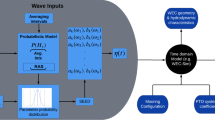Abstract
This paper focuses on realistically predicting the power outputs of wave energy converters operating in shallow water nonlinear waves. A heaving two-body point absorber is utilized as a specific calculation example, and the generated power of the point absorber has been predicted by using a novel method (a nonlinear simulation method) that incorporates a second order random wave model into a nonlinear dynamic filter. It is demonstrated that the second order random wave model in this article can be utilized to generate irregular waves with realistic crest–trough asymmetries, and consequently, more accurate generated power can be predicted by subsequently solving the nonlinear dynamic filter equation with the nonlinearly simulated second order waves as inputs. The research findings demonstrate that the novel nonlinear simulation method in this article can be utilized as a robust tool for ocean engineers in their design, analysis and optimization of wave energy converters.





Similar content being viewed by others
References
Gunn, K., Stock-Williams, C.: Quantifying the global wave power resource. Renew. Energy 44, 296–304 (2012)
Cargo, C.J., Hillis, A.J., Plummer, A.R.: Optimisation and control of a hydraulic power take-off unit for a wave energy converter in irregular waves. Proc. Inst. Mech. Eng. Part A J. Power Energy 228, 462–479 (2014)
Eriksson, M., Isberg, J., Leijon, M.: Hydrodynamic modelling of a direct drive wave energy converter. Int. J. Eng. Sci. 43, 1377–1387 (2005)
Fan, Y.J., Mu, A.L., Ma, T.: Design and control of a point absorber wave energy converter with an open loop hydraulic transmission. Energy Convers. Manag. 121, 13–21 (2016)
Fernandes, M.A., Fonseca, N.: Finite depth effects on the wave energy resource and the energy captured by a point absorber. Ocean Eng. 67, 13–26 (2013)
Gomes, R.P.F., Lopes, M.F.P., Henriques, J.C.C., et al.: The dynamics and power extraction of bottom-hinged plate wave energy converters in regular and irregular waves. Ocean Eng. 96, 86–99 (2015)
Herber, D.R., Allison, J.T.: Wave energy extraction maximization in irregular ocean waves using pseudospectral methods. In: ASME 2013 International Design Engineering Technical Conferences and Computers and Information in Engineering Conference, Portland, OR (2013)
Sánchez, E.V., Hansen, R.H., Kramer, M.M.: Control performance assessment and design of optimal control to harvest ocean energy. IEEE J. Ocean. Eng. 40, 15–26 (2015)
Stelzer, M.A., Joshi, R.P.: Evaluation of wave energy generation from buoy heave response based on linear generator concepts. J. Renew. Sustain. Energy 4, 063137 (2012). https://doi.org/10.1063/1.4771693
Wang, L.G., Isberg, J.: Nonlinear passive control of a wave energy converter subject to constraints in irregular waves. Energies 8, 6528–6542 (2015). https://doi.org/10.3390/en8076528
Yu, Y.H., Hallett, K., Li, Y., et al.: Design and analysis for a floating oscillating surge wave energy converter. In: Proceedings of the International Conference on Offshore Mechanics and Arctic Engineering—OMAE, Volume 9B, San Francisco, United States (2014)
Lindgren, G.: Asymmetric waves in wave energy systems analysed by the stochastic Gauss–Lagrange wave model. Proc. Estonian Acad. Sci. 64, 291–296 (2015)
Forristall, G.Z.: Wave crest distributions: Observations and second-order theory. J. Phys. Oceanogr. 30, 1931–1943 (2000)
Toffoli, A., Onorato, M., Monbaliu, J.: Wave statistics in unimodal and bimodal seas from a second-order model. Eur. J. Mech. B. Fluids 25, 649–661 (2006)
Wang, Y.G., Xia, Y.Q.: Simulating mixed sea state waves for marine design. Appl. Ocean Res. 37, 33–44 (2012)
Wang, Y.G., Xia, Y.Q.: Calculating nonlinear wave crest exceedance probabilities using a Transformed Rayleigh method. Coast. Eng. 78, 1–12 (2013)
Wang, Y.G.: Calculating crest statistics of shallow water nonlinear waves based on standard spectra and measured data at the Poseidon platform. Ocean Eng. 87, 16–24 (2014)
Wang, Y.G.: Nonlinear crest distribution for shallow water Stokes waves. Appl. Ocean Res. 57, 152–161 (2016)
Dias, F., Renzi, E., Gallagher, S., et al.: Analytical and computational modelling for wave energy systems: the example of oscillating wave surge converters. Acta. Mech. Sin. 33, 647–662 (2017)
Marthinsen, T.: On the Statistics of Irregular Second-Order Waves. Stanford Report RMS-11 (1992)
Langley, R.S.: A statistical analysis of non-linear random waves. Ocean Eng. 14, 389–407 (1987)
Hasselmann, K.: On the non-linear energy transfer in a gravity-wave spectrum, Part 1. General theory. J. Fluid Mech. 12, 481–500 (1962)
Ochi, M.K.: Ocean Waves, the Stochastic Approach. Cambridge University Press, Cambridge (1998)
Chakrabarti, S.K.: Hydrodynamics of Offshore Structures. Computational Mechanics Publications, Southampton (1987)
Acknowledgements
The work was supported by the State Key Laboratory of Ocean Engineering of China (Grant GKZD010038). Special thanks are due to the two anonymous reviewers whose valuable comments have led to the improved quality of this paper.
Author information
Authors and Affiliations
Corresponding author
Rights and permissions
About this article
Cite this article
Wang, Y. A novel method for predicting the power outputs of wave energy converters. Acta Mech. Sin. 34, 644–652 (2018). https://doi.org/10.1007/s10409-018-0755-2
Received:
Revised:
Accepted:
Published:
Issue Date:
DOI: https://doi.org/10.1007/s10409-018-0755-2




